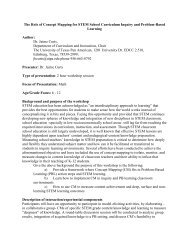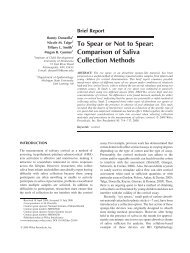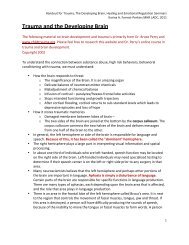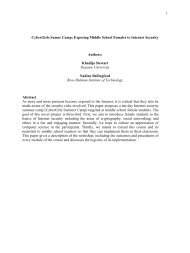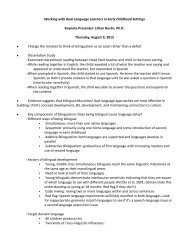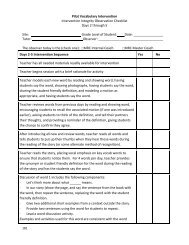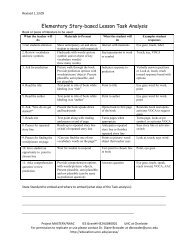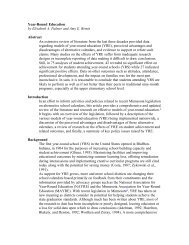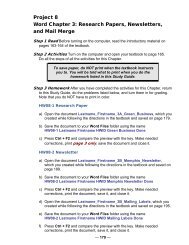Introduction to Positive Ways of Intervening with Challenging Behavior
Introduction to Positive Ways of Intervening with Challenging Behavior
Introduction to Positive Ways of Intervening with Challenging Behavior
Create successful ePaper yourself
Turn your PDF publications into a flip-book with our unique Google optimized e-Paper software.
What should I do when violence seems imminent?<br />
First, put your plan in<strong>to</strong> action. Then move anything which may be used as a weapon (chairs, books, pencils, etc.)<br />
away from the student. Consider whether it is necessary for the other students <strong>to</strong> leave the room. Make sure that<br />
the student has about three feet <strong>of</strong> space around him or her and that he or she is not cornered. A student who feels<br />
caged is much more likely <strong>to</strong> attack. Furthermore, make sure that the student has an escape route. If you stand<br />
between the student and escape, he or she may do whatever is necessary <strong>to</strong> access that escape.<br />
When approaching a student who is upset, Hughes (1985) recommends taking the following steps:<br />
1. Assume a nonthreatening posture. Keep you hands in front <strong>of</strong> your body and free in case you need <strong>to</strong> block a<br />
punch if the student does attack.<br />
2. Speak in a soothing voice, calling the student by name. Tell the student what you want him or her <strong>to</strong> do and do<br />
not lie <strong>to</strong> the student about what you will or will not do.<br />
3. Approach the upset student slowly, from the front and slightly <strong>to</strong> one side. Leave the student personal space,<br />
maintain eye contact, and speak s<strong>of</strong>tly.<br />
Where can I get more information and training in the use <strong>of</strong> physical restraint?<br />
It is very important for all staff <strong>to</strong> have formal training from pr<strong>of</strong>essional trainers so that if physical restraint ever<br />
is necessary, everyone is comfortable and confident in using it properly. Contact you school district <strong>of</strong>fice or your<br />
district's special education <strong>of</strong>fice <strong>to</strong> find out if inservice training is provided. Other resources include:<br />
National Crisis Prevention Institute, Inc.<br />
3315-K North 1245h Street<br />
Brookfield, WI 53005<br />
1-800-558-8976<br />
References<br />
Friman, P.C. (1990). Nonaversive treatment <strong>of</strong> high-rate disruption: Child and provider effects. Exceptional Children, September, 64-69.<br />
Hughes, C. (1985). Physical intervention: Planning and control techniques. Pointer, 29, 34-37.<br />
Morgan, D.P., & Jenson, W.R. (1988). Teaching behaviorally disordered students: Preferred practices. Columbus: Merrill.<br />
Schloss, P.J., & Smith, M.A. (1987). Guidelines for ethical use <strong>of</strong> manual restraint in public school settings for behaviorally disordered<br />
students. <strong>Behavior</strong>al Disorders, May, 207-213..<br />
Singh, N.N., Win<strong>to</strong>n, A.S., & Ball, P.M. (1984). Effects <strong>of</strong> physical restraint on the behavior <strong>of</strong> hyperactive mentally retarded persons.<br />
American Journal <strong>of</strong> Mental Deficiency, 89, 16-22.<br />
S<strong>to</strong>ne, L. (1990). Managing difficult children in school. Oxford, England: Basil Blackwell, Ltd.<br />
Wolfgang, C.H. (1995). Solving discipline problems: Methods and models for <strong>to</strong>day's teachers. Needham Heights, Massachusetts: Allyn &<br />
Bacon.<br />
This publication was supported by Grant #H029K20171, Special Project <strong>to</strong> Provide Technical Assistance, Inservice Training<br />
and Site Development for <strong>Positive</strong> <strong>Behavior</strong>al Support Strategies for Students <strong>with</strong> Disabilities from the U.S. Department <strong>of</strong><br />
Education. The University <strong>of</strong> Minnesota is an equal opportunity employer and educa<strong>to</strong>r.




